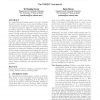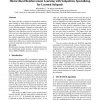1233 search results - page 27 / 247 » Feudal Reinforcement Learning |
ECML
2004
Springer
14 years 1 months ago
2004
Springer
Abstract. We investigate the problem of using function approximation in reinforcement learning where the agent’s policy is represented as a classifier mapping states to actions....
KCAP
2009
ACM
14 years 2 months ago
2009
ACM
As computational learning agents move into domains that incur real costs (e.g., autonomous driving or financial investment), it will be necessary to learn good policies without n...
NCI
2004
13 years 9 months ago
2004
This paper describes a method for hierarchical reinforcement learning in which high-level policies automatically discover subgoals, and low-level policies learn to specialize for ...
SCAI
2008
13 years 9 months ago
2008
Abstract. A reinforcement architecture is introduced that consists of three complementary learning systems with different generalization abilities. The ACTOR learns state-action as...
ICML
2007
IEEE
14 years 8 months ago
2007
IEEE
Reinforcement learning algorithms can become unstable when combined with linear function approximation. Algorithms that minimize the mean-square Bellman error are guaranteed to co...


